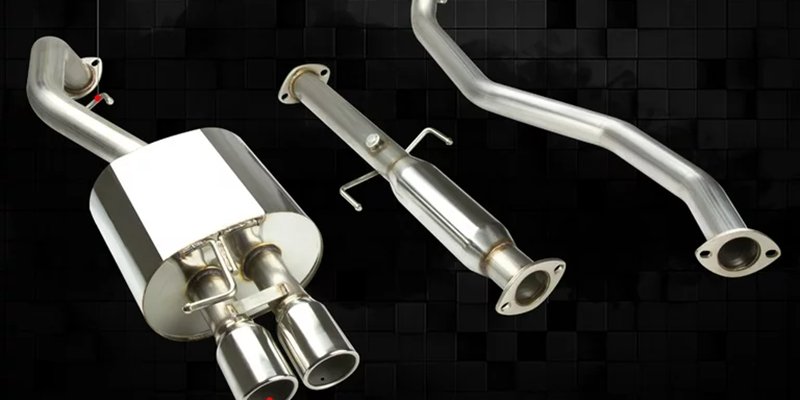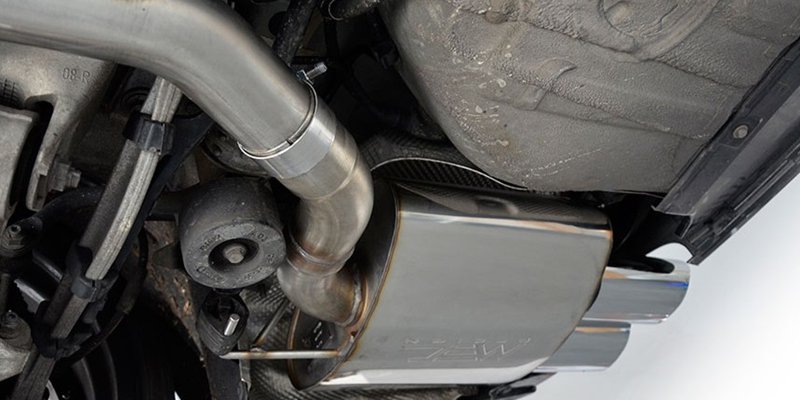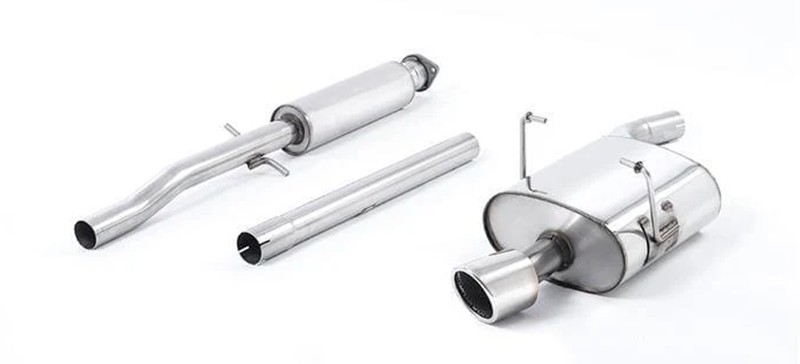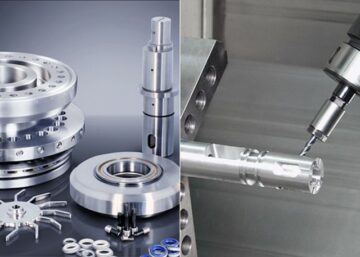A car consists of different systems: the engine, car gearbox and transmission, electrical, cooling, suspension, and exhaust systems, among others. Each system has various components that perform specific functions to ensure the vehicle runs smoothly without hiccups.
Car mufflers are an essential component, part of the exhaust system, responsible for muffling excessive sounds and noise that these exhaust gases may cause. In addition, a car muffler is important for the smooth and convenient running of the vehicle, among other benefits.
This article explores what a muffler is, its role, its components, and how it works.
 What is a Muffler?
What is a Muffler?
The car muffler is an integral part of the exhaust system, located close to the exhaust pipes at the vehicle’s rear. As the name suggests, it’s a component that aids in muffling and reducing the sounds and vibrations produced by the car engines.
The noise muffling action results from the bulkhead and a winding pipe, two important features of a typical car muffler. Consequently, some refer to the muffler as a silencer, as it helps to reduce noise – a byproduct of the car engine combustion process.
Car mufflers are usually manufactured using sturdy materials like aluminum and steel, creating a bridge between the car engine and the exhaust system. However, the car muffler enhances the overall car performance and optimizes its appearance besides muffling, silencing, and dampening noise.
 Function and Purpose of Mufflers in Automotive Systems
Function and Purpose of Mufflers in Automotive Systems
Car mufflers are sometimes called silencers because they help to silence the noise of high-pressure exhaust gases released. This section discusses in detail the muffler’s purpose and functions in automotive devices.
Noise Muffling and Reduction
The primary function of a muffler on a car is to muffle noise and vibration from high-pressure gasses released from internal combustion engines. During the engine running, it creates high power, resulting in various pulsating sounds and vibrations in the exhaust system. Therefore, without a functioning muffler, the overall sounds made by the vehicle will be enormous.
In fact, when you start to notice an overly loud noise and vibration than you’ll typically hear, it’s a signal that there’s an issue with your vehicle’s muffler and exhaust system. Therefore, using an efficient muffler will help improve the sound, reduce noise pollution in the environment, and promote a more comfortable driving experience for the driver.
Backpressure Regulation
When the car runs, the engine valves are always in quick motion, moving in multiple directions. This rapid motion causes the release of back pressure, limiting the overall car functionalities. Therefore, finding the right balance of this backpressure is essential to optimize the car’s performance. Besides reducing noise pollution, this may be the most critical role of the car muffler, as it helps reduce back pressure, limiting the car’s functions and overall efficiency.
Enhance Overall Car Aesthetics
Like other car parts, mufflers have different design specifications to suit your taste and theme. Therefore, you can select or create a custom muffler that suits your needs. This will attract higher costs, but you will get to improve your overall car appearance and aesthetics. Also, beyond the beautification, be sure to select a muffler that seamlessly integrates with your car shape and design features.
Optimize Car Engine Performance
As mentioned earlier, mufflers help regulate the release of exhaust gasses, allow the entry of fresh gasses for combustion, and improve engine performance. This allows the vehicle to generate higher energy for more power and smooth driving. Also, through enhancing exhaust flow, the muffler aids in improving fuel economy for more efficient driving and more seamless running of the engine.
Protects the Car Exhaust System
Besides all the functions discussed above, car exhaust mufflers also serve protective functions. They help prevent contaminants like dirt and debris from entering the car’s exhaust system. The muffler acts like a filtering system, filtering off these contaminants and preventing them from penetrating the exhaust system.
 Components of a Car Muffler
Components of a Car Muffler
Automotive mufflers consist of different components, allowing the part to perform its function.
Outer Ahells
The outer shell of a typical car muffler serves as the protective covering. Therefore, it is usually composed of sturdy and durable materials like aluminum or steel. It protects the internal features of the muffler from external components, ensuring its resilience against external factors and promoting its longevity.
Sound Absorbing Materials
Since the muffler on a car offers a noise-deadening feature, there needs to be a component that allows it to provide this feature. The internal components of a car muffler consist of sound-absorbing material, often made of fiberglass.
Perforated Tubings
The perforated tubings help to guide and shape the exhaust bases as they pass and filter through other tubes and compartments. The perforation in these tubes lows for easy flow of the gases, contributing to the noise silencing and backpressure regulation.
Baffles
The baffles are internal partitions within the muffler that alter the direction of the flow of exhaust bases. The primary role of this component is to aid backpressure regulation and modulate noise created by these gasses.
Mounting Brackets
The mounting brackets secure the muffler within the exhaust system. They ensure optimum alignment of the components that make up the car muffler, preventing excessive movement to keep them out of place. Therefore, the mounting brackets provide stability for the muffler and the entire vehicle exhaust system.
Catalytic Converter
Some mufflers integrate a catalytic converter, a device that helps reduce harmful emissions and atmospheric pollution. The catalytic converter enables specific chemical reactions within the exhaust system that convert active pollutants like carbon monoxide, nitrogen oxide, and hydrocarbons into less harmful substances that suit environmental regulations.
 How Does a Muffler Work?
How Does a Muffler Work?
The muffler is the part of the exhaust system that resembles a tube. Its principal function is to act as a silencer, dampening the noise of exhaust gasses. Before exhaust fumes are released from your vehicle, it passes through an absorber – the muffler.
The operational function of a muffler combines mechanical and acoustic principles. Generally, the exhaust manifold produces gas fumes, usually at high pressure and temperature, causing a rapid expansion of these gasses – the cause of the loud sound.
However, as the gas approaches the muffler, its sound-absorbing materials absorb some sound waves, converting some of the sound (acoustic) energy into heat. The baffles and chambers within the muffler then alter the direction of the gasses, causing interference in the sound waves, resulting in the canceling of specific frequencies and further noise reduction.
Also, these gasses pass through perforated tubes, which direct the dunes through small tubes, further disrupting the sound and contributing to more noise reduction.
Types of Mufflers
Automotive mufflers exist in different shapes and configurations, exhibiting specific designs that can help improve the car’s aesthetics. Below are common types present in automobiles.
Straight Flow Mufflers
This muffle type features a simple and direct design, with a straight pipe channel with holes around it, indicating its name. It features a layer of absorbent material that aids in absorbing noise from the exhaust fumes.
However, the straight-flow muffler design is such that the gasses flow in a straight direction with little to no restrictions, resulting in louder exhaust notes with a distinctive sound as heard in high-performance and racing vehicles.
Zigzag Mufflers
Zigzag mufflers integrate a series of small chambered mufflers or baffles into a single muffler design. Its characteristic zig-zag space on the tube contributes to its effective noise dampening, backpressure regulation, and exhaust emissions. This muffler is a delicate balance of mild exhaust sounds and engine performance.
Resonance Chamber Mufflers
Resonance chambers operate on the principles of resonance to dead our specific sound frequencies. This muffler is a chamber with multiple holes, enabling gas expansion and optimizing the exhaust performance. OEMs strategically place holes in these mufflers, causing interference in the soundwaves and effectively dampening the noise.
 Materials Used in Car Muffler Manufacturing
Materials Used in Car Muffler Manufacturing
Different materials suit the manufacturing of car mufflers. Below is a description of some of the common ones.
Carbon Steel
Carbon steel is a common and cost-effective material for fabrication because of its impressive mechanical properties. These features also make it a suitable choice for creating car mufflers.
Aluminium
Aluminum is another common metal of choice for various manufacturing and fabrication purposes. It is a standard metal in the automotive sector, offering a significant strength-to-weight ratio. Therefore, it’s an excellent option for manufacturing the mufflers of high-end and racing vehicles that need to cut down the overall car weight. Also, it is durable and offers high resistance to corrosion.
Stainless Steel
Besides carbon steel, other steel alloys, such as stainless steel, may also be suitable for fabricating mufflers. They are strong, highly durable, corrosion resistant, and ideal for manufacturing various muffler components such as pipes and baffles.
 Manufacturing Processes for Car Exhaust Mufflers
Manufacturing Processes for Car Exhaust Mufflers
Car mufflers come in different designs, allowing various manufacturing processes to make them. Below is a brief overview of typical industrial processes used to manufacture mufflers.
Welding
Welding is a necessary process used in creating car mufflers, as the process involves joining pieces of metal structures together. Therefore, automotive welding suits the joining of different parts of the mufflers, particularly the inlet and outlet pipes, mounting brackets, and baffles. Manufacturers typically adopt either of the most typical welding techniques – MIG or TIG welding to ensure a secure, stable, and durable connection of these parts.
Tube Bending
Mufflers consist of different pipes and tubings, especially the perforated tubes and inlet and outlet pipes. Therefore, the need for a fabrication process ensures the restructuring of these tubes to achieve specific shapes that allow easy exhaust flow and suit the car design. Tube bending is just the correct method for this. The process enables bending metal tubes and sheets to specific angles and shapes, forming curves and configurations that suit the car design, allowing optimal gas flow.
Stamping and Forming
Stamping involves the cutting and shaping of metal pieces and sheets to form specific shapes while developing processes allow the reshaping of these metals under high pressure. Both methods are effective for creating components of automotive mufflers, like the outer shells and baffles. However, stamping tends to use pre-mood dies for its cutting, while forming allows more intricate designs and contours to be manufactured.
Punching
Punching suits the creation of perforations in tubings or baffles. This process is essential for designing mufflers with specific acoustic properties. For example, the punched holes’ size, pattern, and distribution impact the muffler’s ability to effectively absorb and dissipate sound waves.
Drilling
CNC drilling is a machining process that involves removing material components using a drill bit. It is specifically used for creating holes in a component, such as the mounting brackets of a car muffler. The process is accurate and precise, ensuring proper alignment of the mounting point.
Surface Finishing Options for Automotive Mufflers
After manufacturing car exhaust mufflers, different surface finishing options are suitable for enhancing these components. The finishes allow the improvement of aesthetics and overall quality of the fabrication.
Galvanizing
Galvanization involves coating a natal component with zinc to improve its corrosion resistance. This process is a compatible finish for car mufflers, mainly if fabricated using carbon steel. Galvanizing helps to create a protective layer for the steel alloy with zinc, ensuring it is more resistant to rust and corrosion. Therefore, the resulting component is more durable with an extended lifespan and suits harsh environments.
Powder Coating
Powder coating is a similar finish to paint. However, the process coats the surfaces with dry powders instead of paint or lacquers. Still, it achieves identical results and a more aesthetic appearance, allowing the integration of specific colors for the mufflers.
Anodizing
Anodizing is an electrochemical process that involves coating the surface of a metal with a protective oxide layer through controlled oxidation. However, it is commonly used for components made of aluminum, a suitable metal for creating car mufflers. Besides increasing durability and corrosion resistance, this finish offers various color combinations, enhancing parts aesthetics.
Chrome Coating
Chrome coating creates a decorative finish with a lustrous reflective surface on a material surface. However, beyond aesthetics, it also offers additional protection against corrosion and gives the muffler a polished appearance.
WayKen Expert Services for Automotive Parts Manufacturing
Are you looking to customize your car components and parts? At WayKen, we specialize in automotive prototyping and custom car parts manufacturing. We boast highly skilled professionals and over 20+ years of industry experience who understand how effective to manufacture your parts and ensure quality. Contact us today and get a free quote!
Conclusion
The main purpose of car mufflers is to reduce noise and promote a more comfortable driving experience. However, as it reduces noise, it also performs some functions like filtering and regulating car emissions – exhaust fumes – thereby reducing pollution.
FAQs
What exactly do car mufflers do?
The primary function of car mufflers is to reduce exhaust noise and regulate car emissions. Other functions include regulating backpressure, protecting the exhaust system, and enhancing the car’s engine and overall performance.
What happens to a car when the car muffler is removed?
Removing the muffler on a car will cause a significant increase in exhaust noise, higher emissions beyond environmental regulations, and a potentially adverse effect on engine performance.
What materials for car Mufflers best suit high-end vehicles?
Aluminum is the go-to choice for manufacturing parts for high-performance vehicles, including the muffler. This lightweight material contributes to weight reduction and enhances the engine’s performance.




